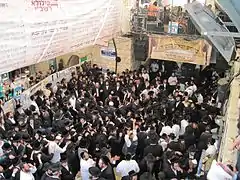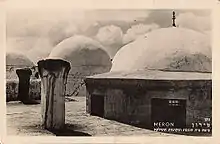Hillula of Rabbi Shimon bar Yochai
Every year on Lag BaOmer, some 200,000 people flock to the 'Yom Hillula' (day of rejoicing) at the tomb of Rabbi Shimon bar Yochai in Meron, Israel.[1] The highlight of the event is the traditional bonfire lit after nightfall on the roof of the tomb, after which celebration with music and dancing begins. From the 13th century onwards, the site became the most popular Jewish pilgrimage site in all of Israel,[2] the celebration first being mentioned by an Italian traveller in 1322.[3] Today it forms the largest mass annual event in Israel.
| Hillula of Rabbi Shimon bar Yochai | |
|---|---|
 Dancing in the yard of the tomb, 2016 | |
| Observed by | Jews |
| Significance | Anniversary of death of Rabbi Shimon bar Yochai |
| Celebrations | Lighting of a bonfire, mass dances |
| Date | 18 Iyar |
| 2022 date | Sunset, 18 May – nightfall, 19 May |
| 2023 date | Sunset, 8 May – nightfall, 9 May |
| 2024 date | Sunset, 25 May – nightfall, 26 May |
| Frequency | Annual |
| Related to | Lag BaOmer |
.jpg.webp)
Origin
According to the Idra Zuta (one of the works printed together with the Zohar), when Rabbi Shimon bar Yochai died, a divine voice called for the occasion to be celebrated as a feast.[4]
Neither Chazal nor the rishonim mention that the date of his death was Lag Baomer.[5] The source for this idea appears to be a passage by R' Chayim Vital which read שמחת רשב"י ("the celebration of Rabbi Shimon bar Yochai") but was mistaken printed as שמת רשב"י ("when Rabbi Shimon bar Yochai died") - a difference of one Hebrew letter.[5] The actual origin of Kabbalistic traditions of visiting Meron on any of several dates in the month of Iyyar date to the medieval period; but it is not clear when, by whom, or in what way Lag baOmer was first connected to Shimon bar Yochai.[5]
Customs
Bonfires

The most well-known custom of Lag BaOmer is the lighting of bonfires. The custom symbolises the "spiritual light" brought in to the world by Rabbi Shimon bar Yochai, to whom the Zohar is ascribed. At the tomb of Rabbi Shimon, the honour of lighting the main bonfire traditionally goes to the Rebbes of the Boyaner dynasty. This privilege was purchased by Rabbi Avrohom Yaakov Friedman of Sadigura from the Sephardi guardians of Meron and Safed. He bequeathed the honour to his eldest son, Rabbi Yitzchok Friedman of Boyan and his progeny.[6] The first hadlakah (lighting) is attended by hundreds of thousands of people annually; in 2001, the crowd was estimated at 300,000.[7] In 2018, 18 different Hassidic Rebbes took turns leading the festivities surrounded by their followers.[8]
An account published in 1848 describes how vast numbers of Jews would arrive at the tomb to celebrate the anniversary of Rabbi Shimon's death. It relates that over the tombs of each of the three rabbis buried in the compound was a cupola and a pillar about 3 ft high which had a hollow scooped out which would hold about 80 pints of oil each. The privilege to set the oil ablaze was sold to the highest bidder, who would use a "costly shawl or richly ornamented dress" to ignite it. "The Jews remain here for 3 days and nights, praying, and reading, and feasting. The money thus obtained, which amounts to a large sum, is employed to keep the building in repair."[9]
Chai rotel
A custom observed during the Hillula is the free distribution of drinks. According to Taamei HaMinhagim, it is a segula (propitious practice) to distribute chai rotel (Hebrew: ח״י רוטל), a liquid measure of about 54 liters. The Hebrew word chai is the numerical equivalent of 18. Rotel is a liquid measure of about 3 liters. Thus, 18 rotels equals 54 liters (about 13 gallons). It is popularly believed that if one donates or offers 18 rotels of liquid refreshment (grape juice, wine, soda or even water) to those attending the celebrations at bar Yochai's tomb on Lag BaOmer, then the giver will be granted miraculous salvation.[10] This practice was endorsed by Rabbi Ovadia miBartenura[11] and The Shelah HaKadosh.[12] The Bobover Rebbe, Rabbi Ben Zion Halberstam, sent a letter from Poland to his Hasidim in Israel asking them to donate chai rotel in Meron on this holy day on behalf of a couple that did not have children.[12] Several local organizations solicit donations of chai rotel and hand out the drinks on the donor's behalf in Meron on Lag BaOmer. Nine months after Lag BaOmer, the Ohel Rashbi organization even invites couples who prayed at the tomb and had a child to come back to Meron to celebrate the births.[11]
Upsherin
_-_First_Haircut.jpg.webp)
It is customary at the Meron celebrations, dating from the time of Rabbi Isaac Luria, that three-year-old boys be given their first haircuts (upsherin), while their parents distribute wine and sweets. Similar upsherin celebrations are simultaneously held in Jerusalem at the grave of Shimon Hatzaddik for Jerusalemites who cannot travel to Meron.[13]
Torah procession
In a tradition started in 1833, on the afternoon preceding Lag Baomer, a Torah scroll belonging to the descendants of Rabbi Shmuel Abu is carried on foot from their home in Safed to the tomb.[8]
Attendance
The gathering has been described as a display of Jewish unity, with all different types of Jews attending, Ashkenazim and Sephardim, religious and secular.[14]
In 2018, the crowd was estimated in excess of 250,000[15] with 5,000 police officers deployed. The event was allocated $4m in funding by the Ministry for Religious Affairs.[8] Organizers said they would be supplying 100,000 liters of cold water and juice and offering parve food which they claimed most pilgrims preferred, (half of the 500 litres of prepared cholent was meatless).[8]
Various government bodies, such as the Ministry of Religions and the Israel Police, prepare for it while investing resources in maintaining order at the event and facilitating traffic to the site. An extensive array of thousands of shuttles is used with more than 1,000 buses bringing the celebrants from all over Israel, making it the largest annual public transportation event in Israel.
Safety concerns
A 2008 report by the State Comptroller of Israel deemed the site inadequate to cater for the large number of annual visitors[16][17] and a 2016 police report warned of issues with infrastructure and crowd control.[18] An attempt by the state to take control over the site in 2011 to address health and safety concerns[19] was met with anger by the private trusts operating the site and a court approved settlement in 2020 ruled that control would remain with the owners.[20]
Incidents
Every year, many people are injured due to over-crowding. On 15 May 1911, a crowd of about 10,000 filled the compound. A railing of a nearby balcony collapsed with about 100 people falling from a height of roughly 7 metres (23 ft) to the ground, resulting in the deaths of 11 people and 40 injured.[21][22] On 30 April 2021, with about 100,000 people in attendance, a deadly crush occurred in which 45 people were killed and more than 150 injured.
Gallery
 Tomb area on Lag BaOmer 2006
Tomb area on Lag BaOmer 2006 The place where the Boyan followers lit the fire, 1920
The place where the Boyan followers lit the fire, 1920 The Torah scroll of the Abu family
The Torah scroll of the Abu family
See also
References
- Schwartz (1999), p. 47.
- Horden, Peregrine; Purcell, Nicholas (2000), The Corrupting Sea: A Study of Mediterranean History, Blackwell Publishing, ISBN 9780631218906, p. 446: "From the thirteenth century the most frequented pilgrim shrine for Jews in Palestine was at Meiron in Galilee… While it was a prominent local religious centre in late Antiquity, with a fine synagogue built in a conspicuous position and a much-venerated copies spring, it had then nothing like the status which it would acquire in the Middle Ages."
- Bension (1932), Preface, xxxi.
- Idra Zuta 179
- Brodt, Eliezer. "A Printing Mistake and the Mysterious Origins of Rashbi's Yahrzeit". seforimblog.com. Archived from the original on 13 May 2020. Retrieved 7 May 2015.
{{cite web}}: CS1 maint: bot: original URL status unknown (link) - Rossoff, Dovid (2005). קדושים אשר בארץ: קברי צדיקים בירושלים ובני ברק [The Holy Ones in the Earth: Graves of Tzaddikim in Jerusalem and Bnei Brak] (in Hebrew). Jerusalem: Machon Otzar HaTorah. pp. 315–316.
- Brayer, Rabbi Menachem (2003). The House of Rizhin: Chassidus and the Rizhiner Dynasty. Mesorah Publications. p. 435. ISBN 1-57819-794-5.
- Kobi Nachshoni, Ahiya Raved, Eli Mandelbaum, Yitzhak Tessler, Eitan Elhadaz. (5 March 2018). Thousands gather in Meron for Lag B'Omer celebration, Ynet.
- Jewish Missionary Intelligence. 1848. p. 370.
- Lebovits, Moishe Dovid. "Lag BaOmer" (PDF). Halachically Speaking. p. 6. Archived from the original (PDF) on 12 May 2013. Retrieved 27 April 2010.
- "Over 500,000 Expected in Meron for Lag Ba'omer, 5769". matzav.com. 11 May 2009. Retrieved 28 April 2010.
- "Chai Rotel Segulah". YeshuosRashbi.com. Retrieved 14 April 2013.
- Rossoff, Dovid. "Meron on Lag B'Omer". The Jewish Magazine. Retrieved 28 April 2010.
- Nathan Jeffay. (15 May 2008). At Grave of Famed Rabbi, Feuding Trustees Find Little Common Ground, Forward.
- Pileggi, Tamar (3 May 2018). "Hundreds of thousands flock to Galilee tomb for Lag B'Omer celebrations". The Times of Israel. Retrieved 22 May 2019.
- דרוקמן, ירון (30 April 2021). "מבקר המדינה מצא ליקויים בקבר הרשב"י כבר לפני 12 שנה: "אין לאפשר את המצב הקיים"". ynet. Archived from the original on 2 May 2021. Retrieved 30 April 2021.
- "News1 מחלקה ראשונה". www.news1.co.il. Archived from the original on 20 April 2021. Retrieved 30 April 2021.
- JAFFE-HOFFMAN, MAAYAN (1 May 2021). "After Meron tragedy: How to survive a crowd crush". The Jerusalem Post. Archived from the original on 2 May 2021. Retrieved 1 May 2021.
- "הממשלה החליטה להלאים את קבר הרשב"י". Haaretz. 27 November 2011. Archived from the original on 2 May 2021. Retrieved 30 April 2021.
- "המהלך להפקעת מתחם קבר הרשבי במירון נעצר; במקומו – הסדר ל-3 שנים". www.nadlancenter.co.il. Archived from the original on 2 May 2021. Retrieved 30 April 2021.
- Maltz, Judy (30 April 2021). "Why do Orthodox Jews flock to the Mt. Meron tomb of Rabbi Shimon Bar-Yochai?". Haaretz.com. Archived from the original on 2 May 2021. Retrieved 30 April 2021.
- "110 years ago, 100 people fell from a balcony at Mt. Meron; 11 were killed". The Times of Israel. 1 May 2021. Retrieved 2 May 2021.
Further reading
- Bension, Ariel. "The Hilulah of Simeon ben Jochai (as it is celebrated today)". The Zohar in Moslem and Christian Spain. Routledge (2016; first published 1932). Part III After the Exile – XIII: pg. 216–223. ISBN 9781315537481
- Schwartz, Yael. (Ed. Rivka Gonen) "The Hillula of Rabbi Shimon bar Yohai at Meron." To The Tombs of the Righteous: Pilgrimage in Contemporary Israel. Israel Museum (1999). pg. 46–59. ISBN 9789652782366